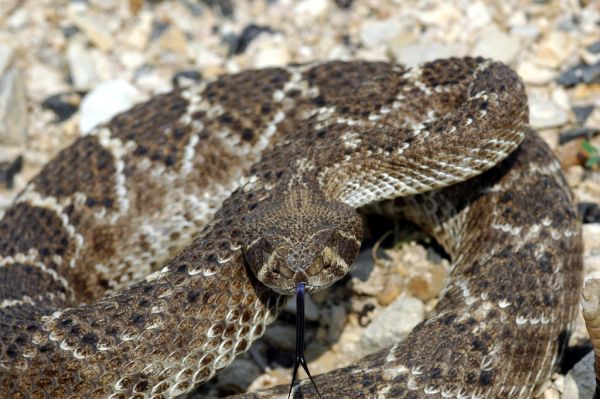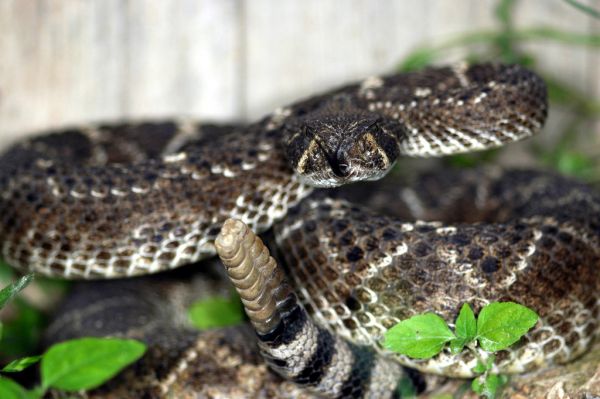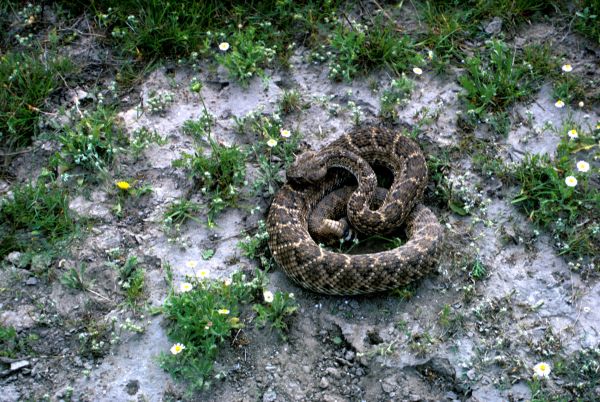Wildlife North America . com North American Animals - mamals, birds, reptiles, insects |
Western Diamondback Rattlesnake (Crotalus atrox)
Western Diamondback Rattlesnake, Val Verde County, Texas Photograph by Clinton & Charles Robertson. Some rights reserved. (view image details) 
Western Diamondback Rattlesnake, Val Verde County, Texas Photograph by Clinton & Charles Robertson. Some rights reserved. (view image details) 
Western Diamondback Rattlesnake Photograph by Luther C. Goldman, U.S. Fish and Wildlife Service. License: Public Domain. (view image details)
WESTERN DIAMONDBACK RATTLESNAKE FACTS
DescriptionThe Western Diamondback Rattlesnake has a gray-brown, pinkish brown, brick red or yellowish, base color with a series of about 24 dark gray-brown or brown blotches. The first few blotches may be more rectangular, further down have a distinctive diamond shape. The tail has 2-8 black bands alternating with white or pale gray. There is a gray or gray-brown stripe on the side of the head behind the eye. The head stripe is usually bordered below by a white stripe. Other Names Western Diamond-backed Rattlesnake, Adobe Snake, Arizona Diamond Rattlesnake, Coon Tail, Desert Diamond-back, Fierce Rattlesnake, Texas Diamond-back Size Length to 120cm. Rarely to 180cm Environment found in arid and semi-arid areas including mountains, deserts, canyons and rocky foothills Food small mammals, birds, lizards. Juveniles may eat large insect, frogs. Breeding Males engage in ritual combat during the breeding season. Combat involves pushing each other with intertwined necks and upper bodies until the weaker snake leaves. Females give birth to as many as 25 live young. Newborns are about 30 cm and capable of giving a venomous bite. Range south east California, Arizona, New Mexico, Oklahoma, Arkansas and Texas in the east, and south into Mexico. Notes The Western Diamondback Rattlesnake is venomous. Bite symptoms include rapid swelling at site of the wound. discoloration and pain. Seek professional medical attention immediately if bitten. Classification
Relatives in same Genus Eastern Diamondback Rattlesnake (C. adamanteus) Sidewinder (C. cerastes) Baja California Rattlesnake (C. enyo) Timber Rattlesnake (C. horridus) Banded Rock Rattlesnake (C. lepidus klauberi) Rock Rattlesnake (C. lepidus lepidus) Southwestern Speckled Rattlesnake (C. mitchellii pyrrhus) Blacktail Rattlesnake (C. molossus molossus) Southern Pacific Rattlesnake (C. oreganus helleri) Great Basin Rattlesnake (C. oreganus lutosus) Northern Pacific Rattlenake (C. oreganus oreganus) Twin-spotted Rattlesnake (C. pricei) Red Diamond Rattlesnake (C. ruber) Mojave Rattlesnake (C. scutulatus) Tiger Rattlesnake (C. tigris) Hopi Rattlesnake (C. viridis nuntius) Arizona Ridgenose Rattlesnake (C. willardi willardi) Home | Mammals | Reptiles | Birds | Insects | Privacy Policy | Disclaimer | Contact Us |